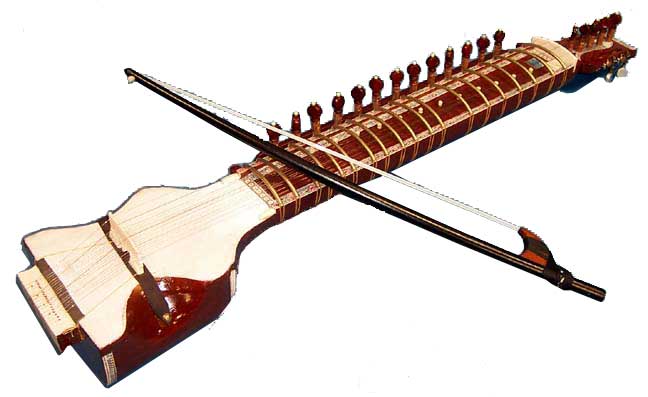


 Pandit Shiv Dayal Batish is a master of the Dilruba. We not only have created an excellent introductory instruction video for the dilruba but he has also recorded a beautiful CD called "Om Shanti Meditation" on the Dilruba that Dilruba fans must try out! Click Here for more information on this.
Pandit Shiv Dayal Batish is a master of the Dilruba. We not only have created an excellent introductory instruction video for the dilruba but he has also recorded a beautiful CD called "Om Shanti Meditation" on the Dilruba that Dilruba fans must try out! Click Here for more information on this.
This instrument is one of the most popular stringed instruments of the bowed variety in Northern India. It is a very clever marriage of the Sitar and the Sarangi. Its fretted finger board resembles that of a Sitar and its belly, upon which the main bridge rests, is covered with goat skin just like on a Sarangi. Both Dilruba and Sarangi are played with a bow, but the Sarangi is considerably smaller.
The birth of this instrument came about two centuries after the introduction of the Sitar and during the Muslim period in Northern India. It is said that When the women in the kings harems took to singing, they could not be accompanied by a Sarangi players since these were mostly men. In the case of the women learning to play Sitar, that also presented a lengthy learning curve and finger calluses that take a along time to develop while creating unsightly finger disfigurement. So expert craftsmen were employed to solve this problem. The instrument's design had to provide for a Sarangi sound but not the Sarangi's difficult learning curve.
The women were not too enthused about playing the Sarangi. Its level of difficulty aside, the sound on this instrument is produced by bowing with one hand and sliding the nails of the other hand along the gut strings (ouch). The gut cuts a groove into the nails and as these nails grow, the need for cutting new grooves in the nails never stops. This can get rather painful especially for the beginner. It also resulted in disfigurement of the nails. The Dilruba was especially constructed to alleviate these problems while retaining the sound qualities and the fluid vocal character of the Sarangi. The bowing action is the same but the other hand plays the strings with the tips of the fingers instead of the nails.
As in the case of the Sitar, the stem of the Dilruba contains eighteen
or nineteen elliptical frets which are movable. They are tied to the
stem by means of thread made of gut (fishing
line is more popular today). The frets can be moved according to the
scale of the raga being played although an accomplished players of this
instrument does not move the frets. They acquire the knack for
skillfully gliding over the strings instead of pressing down on the
frets during note reproduction. This emulates the vocal style meend, gamak,
or taans.

The bridge is placed on goat skin which is glued over a 6 inches by 8 inches hollowed out wooden chamber. Some dilruba makers will put an extra one inch leather strap right below the bridge to strengthen that area so that the bridge's legs don't tear through the main skin. The four main strings go on the top of the bridge and about 22 steel sympathetic strings are placed directly below the top strings with special holes drilled through the bone bridge. Of the 4 main playing strings on the top, two are steel and two are brass. The bridge has a curve so the bowing action can select which string to play but in most instances the playing action is confined to the 1st steel string. The tarab (sympathetic) strings are tuned to reproduce the scale of the raga being performed.
As mentioned earlier, the frets on the Dilruba are meant only to guide the player in locating the correct position of the notes. The fingers do not pull the strings over the frets (as in the case of a Sitar) but glide longitudinally over the strings. All the musical nuances which the Sarangi captures can be faithfully reproduced on this instrument although the faster movements are easier produced on the Sarangi due to its smaller string length.
The Dilruba is held vertically while sitting in a squating position with the lower portion placed on the lap of the performer or in front of the lap, touching the ground. The top rests against the left shoulder.
This instrument is very effective as an accompaniment to vocal music, as an instrument for solo performance or as a composing tool. Simple melodies and the subtlest nuances can be produced with ease.
Pandit Shiv Dayal Batish and Ashwin Batish take you through the basics of this wonderful instrument. This tutor is a must for any serious Dilruba student. All our tutors are available in VHS NTSC and PAL formats. Here are the contents of this one....
Program duration 62 minutes
ISBN 1-882319-54-0
Catalog#: BRV13

copyright ©1995 - 2003 Batish Institute. All rights reserved. Intended For Personal Use Only. No part of the information here may be reproduced or utilized in any form or by any means, electronic or mechanical, including photocopying and recording, or by any information and storage retrieval system, without specific written permission from the Batish family.